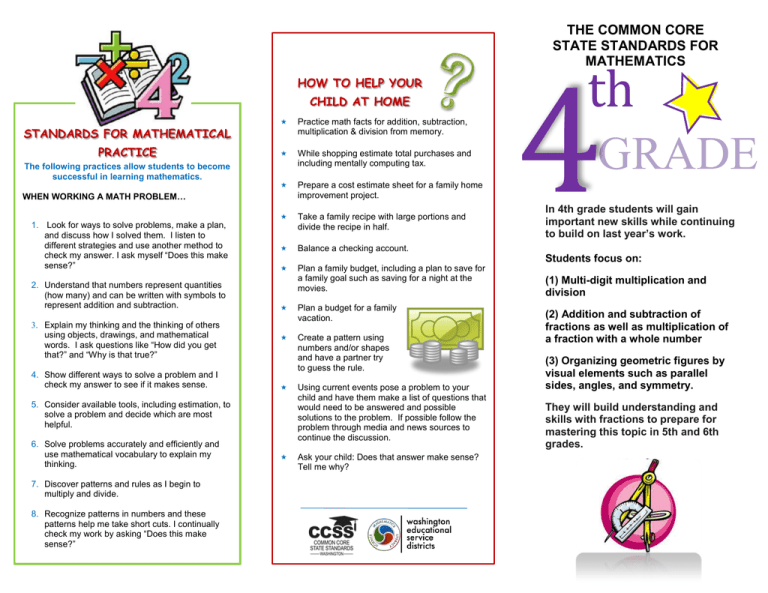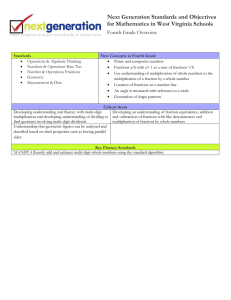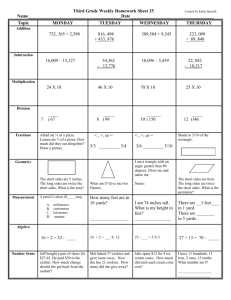4 th GRADE THE COMMON CORE
advertisement

THE COMMON CORE STATE STANDARDS FOR MATHEMATICS HOW TO HELP YOUR CHILD AT HOME STANDARDS FOR MATHEMATICAL PRACTICE The following practices allow students to become successful in learning mathematics. Practice math facts for addition, subtraction, multiplication & division from memory. While shopping estimate total purchases and including mentally computing tax. Prepare a cost estimate sheet for a family home improvement project. Take a family recipe with large portions and divide the recipe in half. Balance a checking account. Plan a family budget, including a plan to save for a family goal such as saving for a night at the movies. WHEN WORKING A MATH PROBLEM… 1. Look for ways to solve problems, make a plan, and discuss how I solved them. I listen to different strategies and use another method to check my answer. I ask myself “Does this make sense?” 2. Understand that numbers represent quantities (how many) and can be written with symbols to represent addition and subtraction. 3. Explain my thinking and the thinking of others using objects, drawings, and mathematical words. I ask questions like “How did you get that?” and “Why is that true?” 4. Show different ways to solve a problem and I check my answer to see if it makes sense. 7. Discover patterns and rules as I begin to multiply and divide. 8. Recognize patterns in numbers and these patterns help me take short cuts. I continually check my work by asking “Does this make sense?” GRADE In 4th grade students will gain important new skills while continuing to build on last year’s work. Students focus on: Plan a budget for a family vacation. Create a pattern using numbers and/or shapes and have a partner try to guess the rule. 5. Consider available tools, including estimation, to solve a problem and decide which are most helpful. 6. Solve problems accurately and efficiently and use mathematical vocabulary to explain my thinking. 4 th Using current events pose a problem to your child and have them make a list of questions that would need to be answered and possible solutions to the problem. If possible follow the problem through media and news sources to continue the discussion. Ask your child: Does that answer make sense? Tell me why? (1) Multi-digit multiplication and division (2) Addition and subtraction of fractions as well as multiplication of a fraction with a whole number (3) Organizing geometric figures by visual elements such as parallel sides, angles, and symmetry. They will build understanding and skills with fractions to prepare for mastering this topic in 5th and 6th grades. OPERATIONS AND ALGEBRAIC THINKING Fourth graders know how to use addition, subtraction, multiplication and division of whole numbers to solve single and multi-step problems. They can write an equation to fit a given situation and use estimation to check to see if their answer is reasonable. EXAMPLES: I can solve problems like these: and different denominators using < , >, =. I know how to add and subract fractions and mixed numbers with the same denominator. Ex. 4 I can apply what I know about multiplication of whole numbers to the multiplication of fractions. A blue hat costs $6. A red hat costs 3 times as much as the blue hat. How much does the red hat cost? Ex. 3 x 2/5 Kim has 28 cookies. She wants to share them equally between herself and 3 friends. How many cookies will each person get? Ex. (7 cookies each) 28 ÷ 4 = c 1/5 Fourth graders are able to make equivalent fractions as well as add and subtract fractions and mixed numbers. They are able to compare and order fractions and decimals. 1/5 I can use a model to show equivalent fractions. 1/5 EXAMPLES: I can express the length of a 4 foot snake as 48 inches. I can find the area of a rectangular room given the length and width using multiplication. Ten students in Room 31 measured their pencils at the end of the day. They recorded their results on the line plot below. X X IN BASE TEN Fourth graders are able to read, write and compare numbers up to one million. They apply place value to multiply and divide multi-digit numbers. I can compare numbers using the symbols < > = Ex. 87 > 75 I know there are 10 groups of 70 in 700. I can use an area model to multiply multi-digit numbers. GEOMETRY Fourth graders are able to measure lines and angles, and identify shapes by their properties. EXAMPLE: I can measure the size of an angle using a protractor. = X X X X __________________________ 3½” 4” 4 ¼” 5 ⅛” EXAMPLES: EXAMPLES: 2/5 NUMBER AND OPERATIONS Ex. For 96 the factor pairs are 1 and 96, 2 and 48, 3 and 32, 4 and 24, 6 and 16, 8 FRACTIONS 2/5 ) Fourth graders are able make a line plot to display data and interpret the data to solve a problem. They convert common units of measurement and know the relative size of measurement units. And use a protractor to measure angles and work with area and perimeter to solve problems. Ex. 0.62 = 62/100 Find factor pairs for numbers up-to 100. NUMBER AND OPERATIONS- is the same as 6 x ( MEASUREMENT AND DATA I can write fractions with the denominators of 10 or 100 as decimals. Decide if an answer is reasonable by using estimation. and 12. - = – = = I can write a fraction in more than one way using the same denominator. Ex. $6 x 3 = h I can compare fractions with different numerators




